Back in January I followed this octopus as it hunted. It explored a rock covered in yellow-green kelp, and as it climbed around, it sometimes produced a perfect match for the colors around it. It was hard to see where seaweed ended and octopus began.
Here is a close-up of the area where the yellows match behind his head.
How do octopuses trick the eye?
One part of what they have to do is produce particular colors. This is done with several layers of specialized cells in their skin. The chromatophores, near the surface, contain sacs of pigment, and the sacs can be expanded or contracted by tiny muscles to reveal or conceal a particular color. The colors of chromatophores vary according to species, but the only available colors are black/brown, red, orange, and yellow. Greens, blues, and violets are produced differently, with the aid of several kinds of reflecting cells that lie deeper in the skin. These cells can refract and scatter light, as well as reflect it straight back. (Here’s a page with a summary of how this works, here’s a more detailed paper, and this new article compares color production in a range of animals.)
So the colors above were probably produced by expanding yellow chromatophores and perhaps using reflecting cells to add some green.
But that is only half the task, and not what I wanted to emphasize. The octopus also has to work out which color to make. And there is the real mystery. Octopuses, it is generally believed, are color-blind. Their eyes are good at detecting brightness, but they have no way to track the hues of the objects around them.
How can you match colors you can’t see? The standard answer is that they use brightness as a clue to color to some extent, and also make use of those tiny mirrors in their skin, the reflecting cells. It’s not necessary to detect and re-make a color if you can just reflect it back.
That is what the books say, but I can’t help thinking there is something missing here. In some of the best cases of camouflage, the octopus’ front side is a good match for the color of what is behind it, and – as far as I can tell – the colors coming in from the front are different from those behind. Then the match to what is behind the octopus can’t be produced by merely reflecting incoming light. That, at least, is how it seems, but it’s hard to tell from casual observation what the light coming from the front is really like.
Here is the same octopus a minute or two before, feeling about under a rock.
(One more shot of him is here.)
Watching it roam around I was reminded of another very camouflaged octopus, of the same species, from a year or so back. This one was uncanny.
I used a photo of his eye in an earlier post. What is especially impressive is the way the arm at the lower right – if you can’t see any octopus there, look for the sucker on the far right– matches the sand-colored rock in front of him, while his head matches the green-grey rock behind.
That shot shows also the role played by adjusting the skin texture, as well as color. Below is another of the same octopus: more conspicuous now, especially as you can see more suckers, and the skin texture also has less going on. (And one more of him, with no camo at all.)
I said above: there seems to be something missing from the explanation about how they do all this. The most interesting speculation floating around is that some light-sensing goes on in the cephalopod skin. In 2010 a paper (by Lydia Mäthger, Steven Roberts, and Roger Hanlon) came out reporting the expression of a gene for a light-sensing chemical in the skin of a cuttlefish. Even if it is being used to sense light, this alone would not solve the color-detection problem, as the light-sensing chemical (the photopigment) in the skin is chemically the same as the single one in their eyes, and the whole point here is that you need at least two kinds of photopigment to discriminate colors. But it might be a piece of the puzzle. I’ve seen a few follow-up references that suggest something like this might be going on in octopuses, too.
_____________
Postscripts. Some beautiful images of starfish skin have just appeared on WetPixel, here, taken by Russian photographer Alexander Semenov.
And again on vision, Deep Sea News has just put up a good short article about the eye of the Giant Squid.

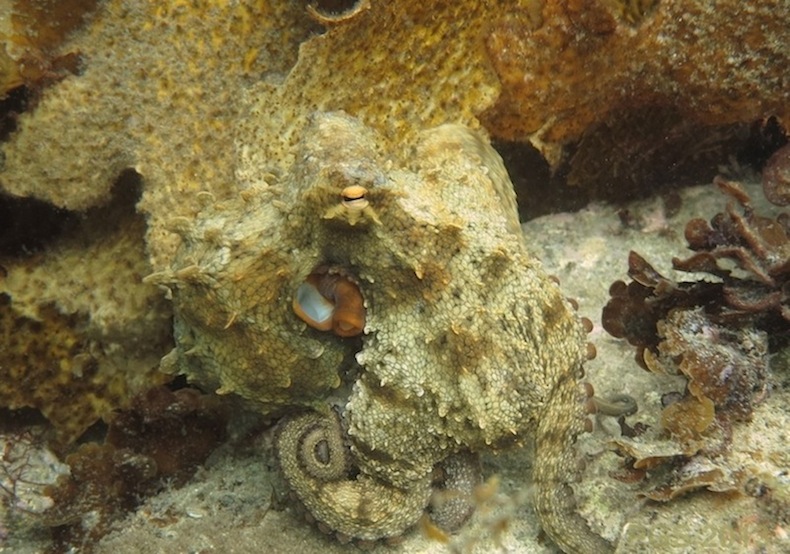
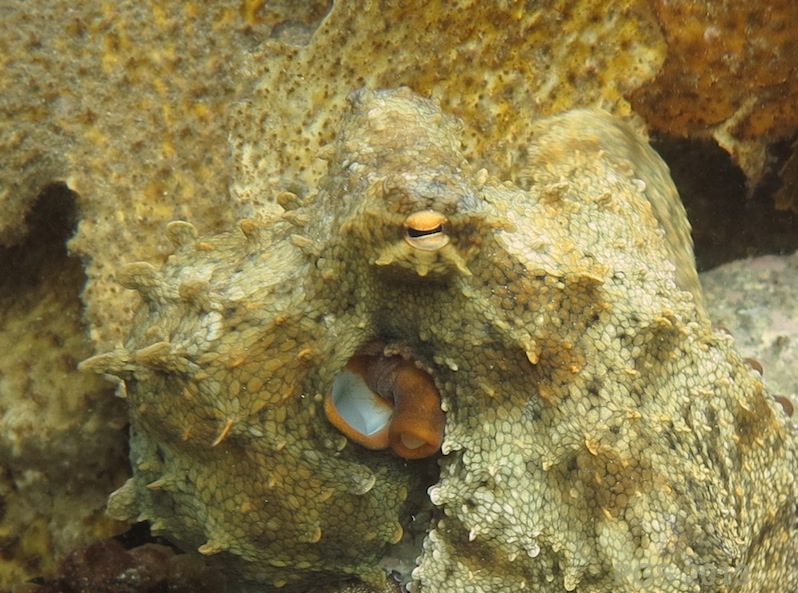
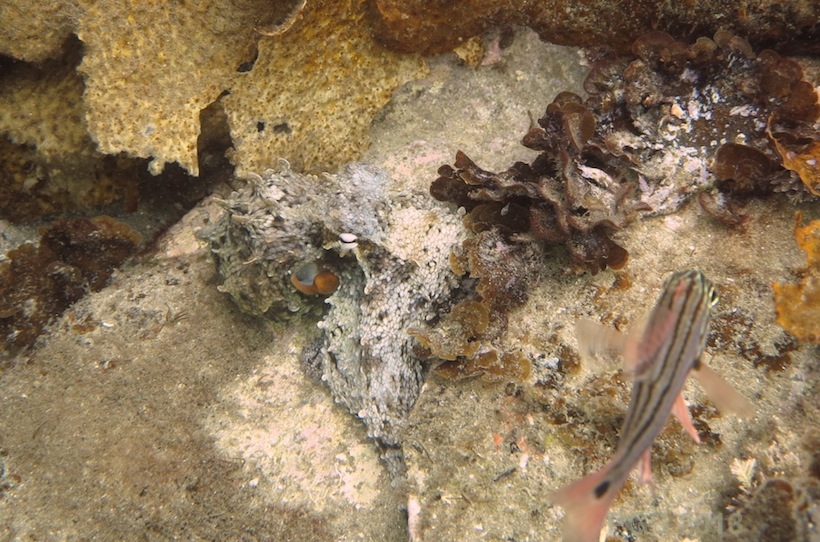

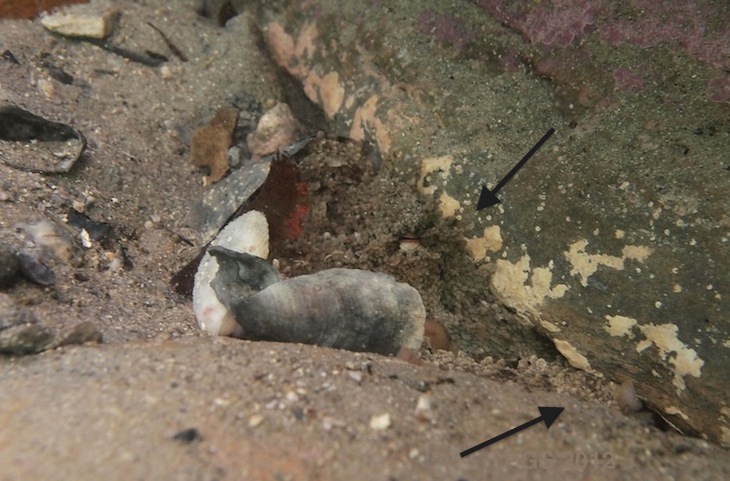
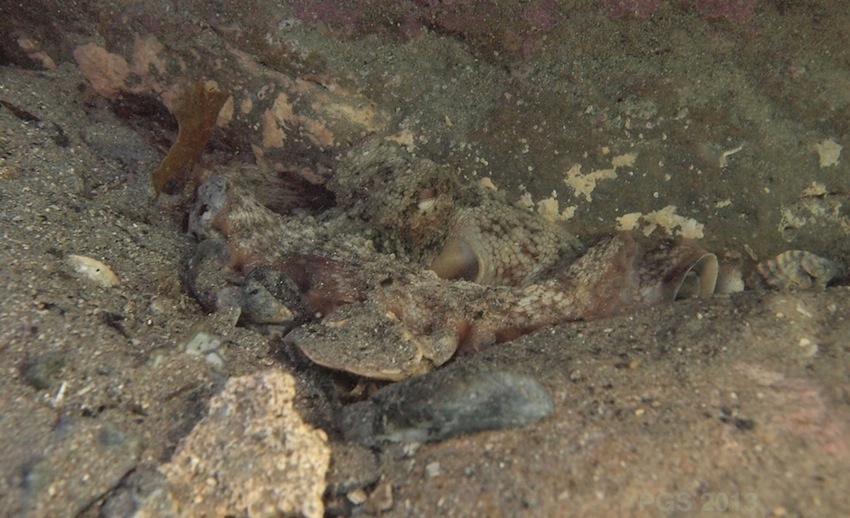
Your writing and photography are both wonderful. Anyway, I had a thought about single-photopigment color discrimination. If the chromatophores are translucent, then just a little bit of quick playing with expanding and contracting different-colored chromatophores would tell the skin what color it was seeing. Suppose the photoreceptors are behind the chromatophores. If the amount of transmitted light is greatly reduced when a yellow-reflecting chromatophore is expanded, but is high when a blue-reflecting chromatophore is expanded, then the light is yellow. So skin can have color vision even with a color-blind photoreceptor. Just a thought.
That is a very interesting idea which I’ve not seen before. Makes sense, as far as I can tell. Essentially, if you have a lot of different colored *filters* available, then you can infer color from brightness, no problem.
This mechanism requires that the photoreceptors be in the right place and that the chromatophores be translucent, as you say. I’ll run this past some people who know more than I do (though I think no one knows much about the possible skin-based system yet).
Thanks for thinking about it! To me as a photographer it makes sense. However, there has to be more to it than this, because as far as I know, the patterns on the skin are not actually copying the pattern of the substrate, but somehow generalizing them. But then since they have extended brains in their legs, maybe this level of processing is also possible in some non-local way.
Hm! Super interesting…
So for this to work, are you saying that the octopus would have to try out all the different filters (expand and contract them) in order to see how the amount of light passing through is changed (or not changed) with filters A, B, C, etc? This procedure could be important for resolving ambiguities like figuring out whether there are low light levels detected because there is a low amount of light of a particular wavelength, vs low light of ALL wavelengths, etc.
And if that is true, is it known that octopi have some kind of “test pattern” camouflage (during which time, they are trying out the different filters to figure out what colors are around them) prior to their display of color-matched camouflage?
This would be pretty amazing evidence in support of Lou’s hypothesis!
Some kind of test pattern would be a neat confirmation, but the octopus could do it without one, if the “neutral” states of chromatophores were different in different cells.
I’m very very interested in how we know octopus camouflage happens in the absence of color vision — is there a large body of behavioral evidence that they are functionally colorblind? I found one or two studies from JB Messenger and colleagues, but not much more.
Light googling and pubmed-ing didn’t turn up much for me regarding photopigments, but there may be better databases or cleverer search terms that would spit out the relevant papers. Also the whole thing made me wish I paid more attention in chemistry! Rhodopsin and retinochrome were both mentioned as pigments that can be found in octopi (Ozaki et al, 1983), but then elsewhere retinochrome seems to be part of the rhodopsin family, perhaps with a different absorption spectrum from other rhodopsins (Terakita et al, 2000).
So could it be that octopi have only one class of photopigments: rhodopsin — but subtypes with different absorption spectra, that could be combined in various ways to yield color vision? This is a very ill-informed question, but I hope the octo-experts here will be kind.
Elsewhere I read that octopi can detect the difference between visual targets that differ only in the presence or absence of a pattern produced by polarization contrast ( Shashar & Cronin, 1996), and this sensitivity to the polarization of light may be due to the highly regular structural organization (consistent angles relative to one another) of the photopigment microstructure (Maethgar et al, 2009). Is there some way octopi’s polarization vision can explain their ability to reproduce colored patterns so well? Or are polarization vision and color vision totally orthogonal… confusion…
I’ve put a new link into the post, on the word ‘believed’ in ‘believed are color-blind,’ which has a jpg of one page from the book Cephalopod Behavior by Hanlon and Messenger, summarizing the evidence for color-blindness as it was in 1996. The behavioral evidence seems pretty good. Essentially, they try to test whether octos notice changes in hue, while holding brightness constant, and apparently they don’t. Octos also failed on learning experiments where they had to learn to respond to a particular hue.
The octopus they used is O vulgaris, which is not the same species as these ones, but closely related. I don’t know enough about the chemistry side here. And then there is the polarization issue. Cephalopods can detect the polarization of light. Could that help? I don’t know. But I know who to ask. More on this soon.
Some more very lightly informed color vision speculation…
We thought for a long time that human color vision was trichromatic (and that is mostly true), but vision scientists at Stanford recently published a paper showing that there is a photopigment, melanopsin, in the human retinal ganglion cell, that is functionally used in color discrimination in certain ranges (http://www.pnas.org/content/110/3/E260).
The point is that there can be photopigments in weird unusual places. This, combined with the possibility that pigments of the same class (rhodopsins) may have different absorption spectra, would be interesting to know and afford the cephalos some color vision.
Also the vision experiments mostly seem to be of the classic psychophysical type — it is possible that in certain ecologically significant contexts, cephalos can reveal that they do act based on color differences — in a way, the camouflage observations would be a great example of this type of evidence, although you can argue that this is possible without color perception per se — but if someone is really convinced by such an argument, then why accept any behavioral evidence of animal color discrimination as grounds for inferring color perception in that animal? What is it like to be an octopus…
Great shots to show the camo. In the tank, they “allow” you to see them when they are well acclimated (and think you are bringing food or want to interact) so trying to get photos where you can’t see them is very difficult. I will not be able to find one and grab the camera just in time to take a shot the shows it clearly. It has almost become a game. Most people want clear photos of their wards, I want to take some where they are hard to see ;).
Center left on the two versions of the photo with the broken shell in front shows something else we see while hunting our aquarium kept animals. If you look to the far left, midway up the photo, there is an octopus, clear as day. However, it is likely an “octopus rock”. We see all kinds of eyes and particularly suckers in the rocks while trying to find one in hiding. Here, again you have captured the image in a way that displays the visual better than I have managed but the fact that you have captured it shows another aspect of how they look like their surroundings.
Took me a while to find it, but there it is. And yes, an octopus-rock.